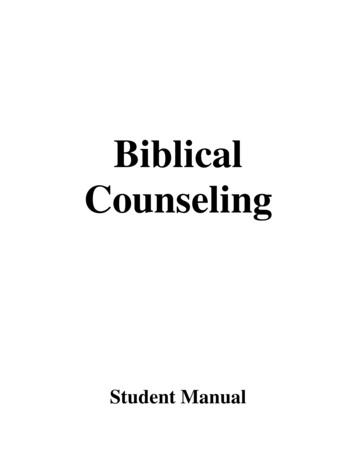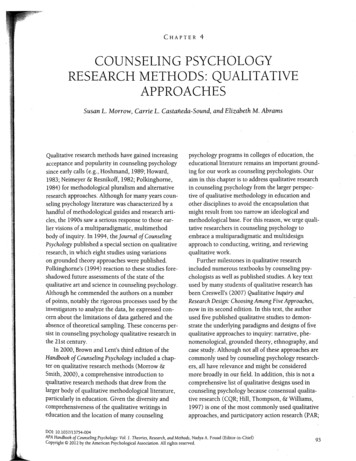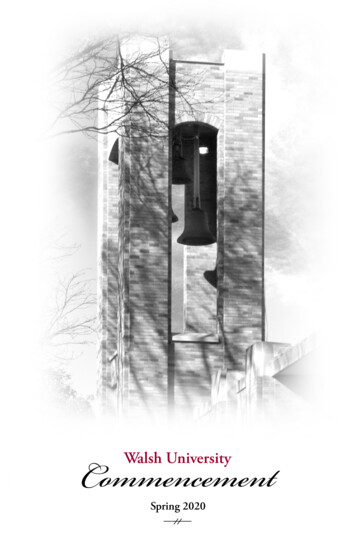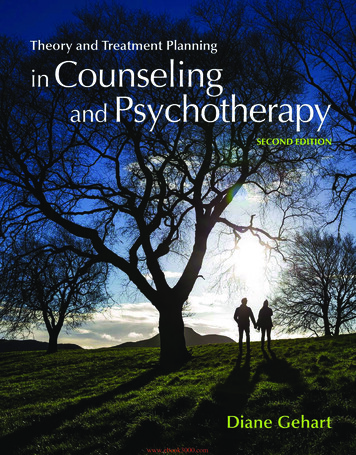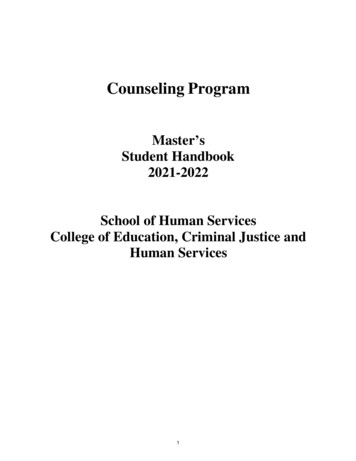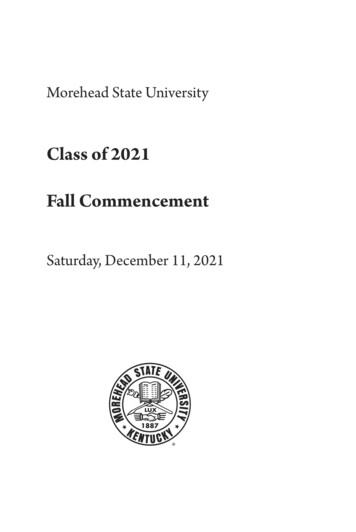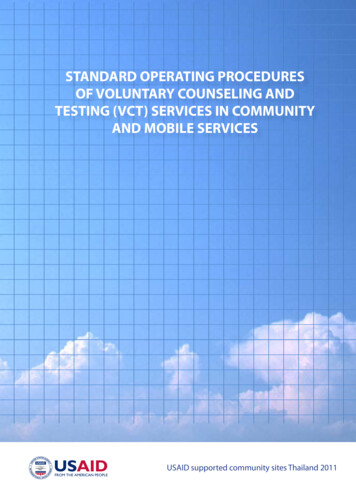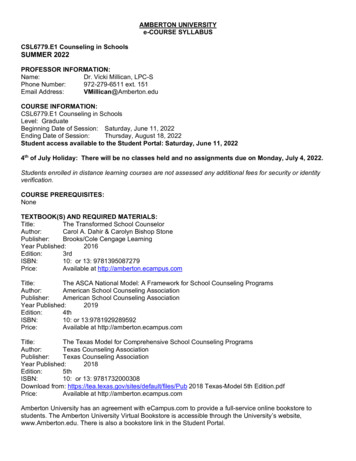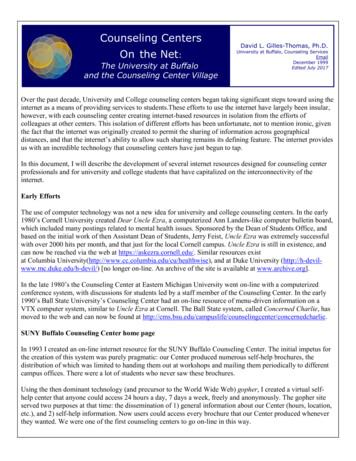
Transcription
Counseling CentersOn the Net:The University at Buffaloand the Counseling Center VillageDavid L. Gilles-Thomas, Ph.D.University at Buffalo, Counseling ServicesEmailDecember 1999Edited July 2017Over the past decade, University and College counseling centers began taking significant steps toward using theinternet as a means of providing services to students.These efforts to use the internet have largely been insular,however, with each counseling center creating internet-based resources in isolation from the efforts ofcolleagues at other centers. This isolation of different efforts has been unfortunate, not to mention ironic, giventhe fact that the internet was originally created to permit the sharing of information across geographicaldistances, and that the internet’s ability to allow such sharing remains its defining feature. The internet providesus with an incredible technology that counseling centers have just begun to tap.In this document, I will describe the development of several internet resources designed for counseling centerprofessionals and for university and college students that have capitalized on the interconnectivity of theinternet.Early EffortsThe use of computer technology was not a new idea for university and college counseling centers. In the early1980’s Cornell University created Dear Uncle Ezra, a computerized Ann Landers-like computer bulletin board,which included many postings related to mental health issues. Sponsored by the Dean of Students Office, andbased on the initial work of then Assistant Dean of Students, Jerry Feist, Uncle Ezra was extremely successfulwith over 2000 hits per month, and that just for the local Cornell campus. Uncle Ezra is still in existence, andcan now be reached via the web at https://askezra.cornell.edu/. Similar resources existat Columbia e), and at Duke University (http://h-devilwww.mc.duke.edu/h-devil/) [no longer on-line. An archive of the site is available at www.archive.org].In the late 1980’s the Counseling Center at Eastern Michigan University went on-line with a computerizedconference system, with discussions for students led by a staff member of the Counseling Center. In the early1990’s Ball State University’s Counseling Center had an on-line resource of menu-driven information on aVTX computer system, similar to Uncle Ezra at Cornell. The Ball State system, called Concerned Charlie, hasmoved to the web and can now be found at cernedcharlie.SUNY Buffalo Counseling Center home pageIn 1993 I created an on-line internet resource for the SUNY Buffalo Counseling Center. The initial impetus forthe creation of this system was purely pragmatic: our Center produced numerous self-help brochures, thedistribution of which was limited to handing them out at workshops and mailing them periodically to differentcampus offices. There were a lot of students who never saw these brochures.Using the then dominant technology (and precursor to the World Wide Web) gopher, I created a virtual selfhelp center that anyone could access 24 hours a day, 7 days a week, freely and anonymously. The gopher siteserved two purposes at that time: the dissemination of 1) general information about our Center (hours, location,etc.), and 2) self-help information. Now users could access every brochure that our Center produced wheneverthey wanted. We were one of the first counseling centers to go on-line in this way.
As time passed, we added additional material such as schedules of events, workshop outlines and handouts, andlinks to other internet resources. The information was structured in a hierarchical list, organized by topic. Theinterface was purely text-based: very plain and very simple:UB Counseling Center Gopher Site, October 1994Counseling Center1.2.3.4.5.6.7.8.9.10.11.12.13.14.About the Counseling CenterWhat is Counseling?What is Group Counseling, and is it for me?Adjusting to life at UBStress and Anxiety/*Relationships/Alcohol and Drugs/Overcoming Depression, and Preventing Suicide/Coping with Death & Grief/Health, Diet, Body Image/Miscellaneous stuff (quotes, poems you never know!)/Recommended Readings on various topics/Workshops/Links to Psychology resources on the internet/*Selections ending with a “/” indicate that there were submenus below that selection.Jim Gerland, SUNY Buffalo Computing Center, was instrumental in teaching me about the technology I neededto use to realize this project. I learned an important lesson at that point: You do not need to know everythingabout the technology to successfully use it, you just need to know someone who does. Through the years, I havereturned to Jim and others in his office (Brandon Plewe, Ross Winston) for assistance with the technical side ofweb development. Their help has been invaluable.Response to this gopher site was dramatic. Within one year usage leapt from 20 hits/month to over 300. (As ofthis writing, the current web version of this site receives over 2000 hits/month).The SUNY Buffalo Counseling Center gopher site quickly made the transition to a full-fledged world wideweb site in 1994-95. This allowed for the hyperlinking of documents, the use of graphics, and a vastly improvedoverall visual appeal. (You can view an archived version of the 1996 version of this website atwww.archive.org). As the site has evolved, we’ve managed to win several awards and accolades, such as theSUNY Faculty Senate Outstanding Student Life award in 1997 (see this screen capture from the UB CounselingCenter website, circa 2000).It became clear quite early that such a resource as our gopher site also could be invaluable to others beyondUB. Indeed, even from the first months our gopher site was being accessed from users all over the world. Theidea of a decentralized internet site emerged, a resource that could minimize the tendency of counseling centerprofessionals to recreate the wheel. The question that arose was “What if we could create an internet site thatwas built on the best of what counseling centers around the country had to offer – a single site that consistedof links to resources located at many and diverse centers?”
The Counseling Center DirectoryBeginning in 1994 I began regularly searching the internet for home pages and gopher sites created byuniversity and college counseling centers. Rather quickly this developed into the creation of an on-line directoryof these sites. As stated in the introductory text of the original Directory, “the sharing of resources such as thoselisted in this document can be invaluable – we can combine our efforts to provide much more effective servicesto students (and others) than if we each work separately. We can examine what our colleagues are doingelsewhere and learn from them. The resources we make available locally will be all the more effective if westay aware of what our colleagues are doing nationally.” Originally consisting of only a handful of counselingcenter sites, this directory now contains over 250 sites and continues to grow weekly. In 1996 the database ofsites in the Directory was growing so large so quickly that the Directory was entirely redesigned to allow easysubmission of new sites and the searching and customized reporting of the existing sites. (The Directory wasdeactivated July 2017 and is no longer available. It has become easier to use google to locate a school’scounseling center website).The Next StepIn 1994 I also began contemplating the idea of creating a list of answers to frequently asked questions (FAQs)based on the discussions that were occurring on the AUCCCD (Association of University and CollegeCounseling Center Directors) listserv. I also proposed via several professional counseling center listservscreating a catalog of on-line resources created by counseling centers:From: David Gilles-ThomasSubject: CC’s on the internetTo: outreach@toe.towson.edu (Counseling Center Outreach List)Date: Thu, 20 Oct 1994Greetings all. The more I talk to colleagues around the country, the more I hear aboutCounseling Centers that are using the internet in various ways. Here at UB we have set up acollection of documents on our gopher server covering a variety of mental health topics. Myguess is there are a lot of other centers doing things with the internet as well. It seemsto me we should let each other know about our efforts.So, if no one else is already doing this, I’d be willing to compile and maintain a list ofresources on the net that are set up by Counseling Centers. If your site has something thatyou would like others to know about, send me the information. I’ll compile the informationI receive and post it back on to this mailing list. This includes gophers, hypertext sites,ftp sites, muds/moos, and mailing lists.Please email me directly.The enormity of such projects slowed things down for some time and so the viability of an AUCCCD FAQ listor a general counseling center resource list faded. In 1996-97, however, the idea of an even larger projectemerged. Bob Hsiung, M.D., of the University of Chicago, had just created the Virtual Pamphlet Collection(Hsiung, 1997), a web site that has become wildly popular for counseling center professionals. Bob hadmanaged to collect in a single web site a massive list of links to self help pamphlets and brochures thatcounseling centers already had on line. It was like our own Center’s on-line self-help brochure collection, buton a grand scale. Bob and I had been in touch for some time by now, and we had been sharing suggestions andresources on our different internet projects. In fact, in 1995 Bob had taken an early gopher version of myCounseling Center Directory and created a simple web version to show me what was possible with a hypertext
document. Our thoughts for the development of the web were quite consistent and complimentary. In themonths just prior to Bob’s announcement of the Virtual Pamphlet Collection, I had actually been working onthe design of essentially the same resource, unaware of Bob’s project. (I, of course, fired off an email to Bob,chastising him for scooping me with his Virtual Pamphlet Collection!).What this illustrated to me at that point was how ripe the time was for using the internet for professionalpurposes. Counseling center professionals were beginning to recognize just how powerful the inter in internetwas.The Counseling Center VillageThe time seemed right to return to my original idea of a large-scale resource for counseling center professionals,but perhaps on even a larger scale than originally contemplated – some sort of “meta web-site.” The CounselingCenter Directory was a large-scale project but was only a listing of counseling center web addresses with briefdescriptions and of limited scope. The Virtual Pamphlet Collection was also large-scale, but focused on onlyone thing: virtual pamphlets and brochures. The internet could provide much more in the way of collaborationand resource sharing for professionals.The day to day demands of my work could have delayed the further development of a meta web-site forever,but in 1996 Wendy Settle of Notre Dame’s Counseling Center learned of my interests and contacted meoffering to collaborate. It was in large part because of her enthusiasm that this project was jump-started andmoved forward. We spent several days designing the initial home-page for a “meta web site” for counselingcenter professionals. Although many of the links at that point were dead-ends, the site served its purpose ofbeing a “proof of concept” – a proposal.The phrase “meta web-site” was pretty ugly and cumbersome, and so I played around with different names. Ifinally settled on the “Counseling Center Village” to capture the idea that because a village is made up of a lotof homes, this web site would be made up of links to a lot of homepages.The Counseling Center Village was formally announced March 21, 1997 at the American College PersonnelAssociation (ACPA) conference in Chicago:I’d like to share with you the Counseling Center Village . This project is not, however, about a physical thing — it is,rather, a concept. And it is a work very much in progress. The purpose of the Counseling Center Village is tocapitalize on the inherent nature of the internet: interconnection. To ignore this nature we risk duplicating efforts,recreating the wheel. we miss the point of the internet: collaboration, sharing, and building on each others’strengths. The Counseling Center Village , then, is about the concept of interconnection across geographicaldistances Wendy Settle of the University of Notre Dame and I have been working on setting up a Counseling CenterVillage Page—something that will bring together in one web page all of these different resources and will includematerials from counseling centers all over such as: Treatment materials, manualsOn-line document bank --- including Bob Hsiung’s (University of Chicago) most excellent on-line VirtualPamphlet Collection.Promotional materialGeneric brochures to be customized by individual schools --- essentially a psychological educational clearinghouseResearch supportStaff development, training materials --- including Gail Hackett’s (Arizona State University) on-line internshiplisting(Gilles-Thomas, 1997)
The mission of the Counseling Center Village was to bring together in a single organized web site the expertiseand resources of counseling center professionals across the country. The majority of the content of the Villageweb pages would be created by counseling centers professionals. Although links to non-counseling center siteswould be included, the emphasis was on gathering together resources, information, and services created bycounseling center professionals. The finalized version of the Village consisted of 10 sections, the first twoalready in existence:1.The Counseling Center Directory2.The Virtual Pamphlet Collection3.Help.Your.Self: Award-winning psychoeducational self help web pages designed for college students.4.Technical Assistance: Assistance on creating or improving a counseling center's web page.5.Practice Resources: Clinical, assessment, and other practice-related resources.6.Workshop Central: Psychoeducational workshop outlines, manuals, handouts, and other materials.7.At The Office: Sample forms and other paperwork, policies and procedures, AUCCCD Document Bank, assessmentinstruments, and more.8.Research Network: A place to exchange ideas, meet and collaborate on counseling center research.9.Staff Development: Professional organizations, staff development program materials, presenters for various topics, joblistings, licensure resources, and counseling listservs.10. Pre-doctoral Training: Pre-doctoral internships, practica, material for seminar presentations, on-line readings, and more.You can follow this link to view an archived version of the Village website, circa 1998.The first task was to identify coordinators for each section of the Village. I was already responsible for theCounseling Center Directory and Bob Hsiung was responsible for the Virtual Pamphlet Collection. WendySettle had created the Help.Your.Self web site specifically for the Village. But that left seven other sections. Acall was put out through ACPA and via email and mailings. The Village became a project sponsored byCommission VII of ACPA, bringing it a much higher profile than previously possible. Over the nextfew months colleagues from around the country volunteered and the Counseling Center Village Board wascreated. Make no mistake, these people have been the heart of the Village web project. Whatever structure Iprovided, these individuals are responsible for the Village being what it is.Village Board Members§Jeff Brooks-Harris, jharris@hawaii.edu, Univ. of Hawaii – Manoa. Coordinator: Workshop Central§Patricia Doherty, pdoherty@uwsp.edu, Univ. of Wisconsin - Stevens Point.§David Gilles-Thomas, dgthomas@buffalo.edu, SUNY Buffalo. Coordinator: The Counseling Center Directory§John Hall, johhall@email.uncc.edu, University of North Carolina at Charlotte. Coordinator: Technical Assistance§Bob Hsiung, dr-bob@uchicago.edu, Univ. of Chicago. Coordinator: The Virtual Pamphlet Collection
§Larry Long, long@tarleton.edu, Tarleton State Univ. Coordinator: At the Office§ Stephen Richey-Suttles, richey@worf.udayton.edu, Univ. of Dayton. Coordinator: Practice Resources§Wendy Settle, wendy.h.settle.1@nd.edu, Univ. of Notre Dame. Coordinator: Help.Your.SelfThe Counseling Center Village (https://ubwp.buffalo.edu/ccvillage/) has quickly become an important tool forcounseling center professionals and students. The Village site, overall, received over 20,000 hits in 1998-99.This number is likely to be a significant underestimate, given the nature of web browser technology and themanner in which hit statistics are calculated. It is more accurate to simply state that the Village received at least20,000 hits. We expect that number to continue to increase as more people become aware of the Village website, and as the content of the Village continues to expand and improve. It has already been extremely successfulin linking counseling center professionals, interested students, and others from all over the world.It has been extraordinarily rewarding for me to be a part of this project, and to work with the extremely talentedcolleagues from around the country who have contributed their time to this project. I can’t imagine a morerewarding professional activity than the collaboration that has been generated by this project. I look forward tothe future developments that we will see in internet technology, and the applications of that technology to thework we do in university and college counseling centers.The FutureInteractive and real-time on-line services will undoubtedly be the next hot topic for counseling centers. On-linesupport groups, bulletin boards, or the more controversial topic, on-line counseling itself, will all need to beaddressed by counseling center professionals. It is my belief that the internet will continue to provide useful andmeaningful adjuncts and alternative to the more traditional services provided by university and collegecounseling centers. This is an area that is growing very quickly in general, and it is important that we have somehand in its development for counseling centers (or we run the risk of it developing without us). Importantgroundwork needs to be done (e.g., issues such as needs assessments, confidentiality, accountability, liability,and effectiveness to name a few). But I do believe there can be a place for on-line services in the workcounseling center professionals do, and that exciting new opportunities for service provision will continue toopen up with these on-line technologies.ReferencesGilles-Thomas, D. L. (1997, March). Innovations in college counseling centers: The CounselingCenter Web. American College Personnel Association Annual Conference, Chicago, Illinois.Hsiung, R. C. (1997). The Student Counseling Virtual Pamphlet Collection: An innovative resource, BehaviorResearch Methods, Instruments, & Computers, 29 (2), 154-157.
UB Counseling Center Gopher Site, October 1994 Counseling Center 1. About the Counseling Center 2. What is Counseling? 3. What is Group Counseling, and is it for me? 4. Adjusting to life at UB 5. Stress and Anxiety/* 6. Relationships/ 7. Alcohol and Drugs/ 8. Overcoming Depression, and Preventing Suicide/ 9. Coping with Death & Grief/ 10 .


